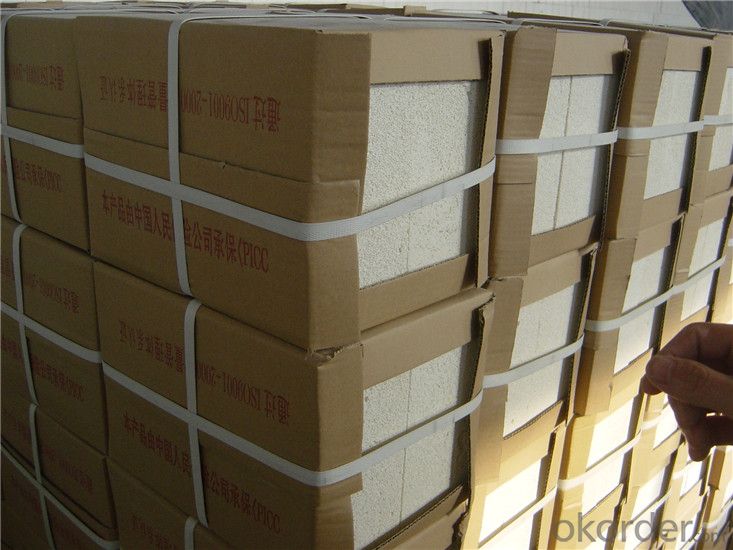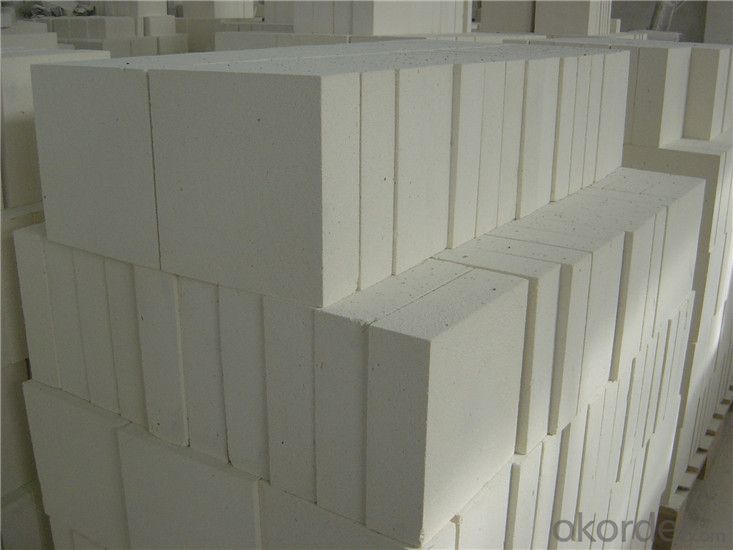Common Size Excellent Insulating Effect Fire Clay Brick Used for Heat Treatment Furnace
- Loading Port:
- Tianjin
- Payment Terms:
- TT OR LC
- Min Order Qty:
- 10 m.t.
- Supply Capability:
- 10000 m.t./month
OKorder Service Pledge
OKorder Financial Service
You Might Also Like
CNBM conforms strictly to the requirements of ISO 9000 quality control system during the production. MSDS is also available if you want. The thermal insulation fire clay brick meet with the requirements of ASTM & JIS standards. So please stay cool with our quality.
Application
Insulating Fire Brick are used for the lining of converter, alternating current arc furnace, direct Current arc furnace and the ladle slag line, etc.
Insulating Fire Brick Technical index
Brand Quality | JM23 | JM26 | JM28 | JM30 | JM32 | |
Bulk Density (g/cm3) | 0.52 | 0.78 | 0.88 | 1.03 | 1.25 | |
1.2 | 1.6 | 2.1 | 2.5 | 3.5 | ||
Modulus of Rupture (Mpa) | 0.9 | 1.4 | 1.6 | 2.1 | 2.1 | |
-0.5 | 1400℃ -0.4 | 1510℃ -0.5 | 1620℃ -0.9 | 1730℃ -0.9 | ||
Thermal Expansion 1100℃(%) |
0.5 |
0.7 |
0.8 |
0.9 |
1.1 | |
Thermal conductivity(W/m.k)
| 400℃ | 0.14 | 0.27 | 0.32 | 0.41 | 0.49 |
600℃ | 0.16 | 0.29 | 0.34 | 0.43 | 0.50 | |
800℃ | 0.18 | 0.31 | 0.36 | 0.44 | 0.51 | |
1000℃ | 0.20 | 0.33 | 0.38 | 0.45 | 0.53 | |
Al2O3 | 37 | 58 | 67 | 73 | 77 | |
Fe2O3 | 0.7 | 0.7 | 0.6 | 0.5 | 0.4 | |
Equipment
1 unit of Ceramic Abrasive (SG Abrasive) pilot production line
2 units of Compact grain Abrasive pilot production lines
1 unit of high-end coated abrasives (abrasive cloth) production line
2 units of Boron Carbide production lines
3 large flexible crushing and sieving lines for grit production lines
2 units of 2000KVA furnaces for Boron Carbide fusion
6 units of 5000KVA-10000KVA dumping type electric arc furnaces for Brown Fused Alumina fusion
Company Advantage
(1)Long Insulating Fire Brick manufacture history: 25 years manufacturer
(2)Advanced equipment
(3)Diversification of production standards: ISO ANSI FEPA JIS ASTM
(4)Flexible payment: T/T L/C D/P D/A
(5)Professional marketing team and after-sale service
(6)Free sample
FAQs
Q1 |
What’s the transport method? |
A1 | FCL delivery goods with wooden pallet or wooden case by sea; If LCL delivery, must with wooden case; Sometimes need open top, flat rack or bulk cargo. |
Q2 |
What’s the required payment term? |
A2 | Generally 30% TT as the prepayment, 70% TT before delivery. If need, 100% Irrevocable Letter of Credit or negotiation. |
Q3 |
Which country are our products exported to? |
A3 | Apart from entire Chinese market, the US, Russia, Japan, Korea, Australia and some Southeast Asian Nations. |


- Q:Are insulating fire bricks resistant to carbon monoxide?
- Yes, insulating fire bricks are resistant to carbon monoxide.
- Q:What is the typical thermal shock resistance of an insulating fire brick?
- The typical thermal shock resistance of an insulating fire brick varies depending on the specific material composition and manufacturing process. However, insulating fire bricks are designed to withstand rapid changes in temperature and can typically handle thermal shock resistance up to 1000°C (1832°F) or even higher.
- Q:Can insulating fire bricks be used in the construction of thermal insulation floors?
- Insulating fire bricks are indeed suitable for the construction of thermal insulation floors. These bricks are specifically designed to possess low thermal conductivity, enabling them to effectively impede heat transfer. Consequently, they are an excellent selection for thermal insulation purposes, including floors. The utilization of insulating fire bricks in the construction of thermal insulation floors can greatly decrease heat loss from the floor, resulting in enhanced energy efficiency and cost savings. Furthermore, these bricks are lightweight and easy to install, making them a practical option for construction projects. All in all, insulating fire bricks offer a suitable and effective means of incorporating thermal insulation into floors.
- Q:Do insulating fire bricks have a low density?
- Yes, insulating fire bricks have a low density compared to other types of bricks. These bricks are designed to have a porous structure, which helps in reducing heat transfer and increasing insulation properties. The low density of insulating fire bricks allows them to provide effective thermal insulation while also being lightweight. This makes them suitable for various applications where heat retention and energy efficiency are important, such as in kilns, furnaces, and fireplaces.
- Q:Can insulating fire bricks be used in residential construction?
- Yes, insulating fire bricks can be used in residential construction. They are commonly used to line fireplaces, wood-burning stoves, and other heating appliances in homes. These bricks are designed to withstand high temperatures and provide excellent thermal insulation, making them suitable for residential applications where heat retention and fire protection are important factors.
- Q:Can insulating fire bricks be used in the construction of brick kilns?
- Yes, insulating fire bricks can be used in the construction of brick kilns. These fire bricks are designed to withstand high temperatures and provide excellent insulation, making them ideal for lining the walls and floors of brick kilns. They help to retain heat, improve energy efficiency, and protect the kiln structure from thermal stress.
- Q:Can insulating fire bricks be used in metal smelting furnaces?
- Yes, insulating fire bricks can be used in metal smelting furnaces. Insulating fire bricks are designed to have low thermal conductivity, which means they can effectively retain heat and prevent heat loss from the furnace. This makes them ideal for use in metal smelting furnaces, where high temperatures need to be maintained for extended periods of time. Additionally, insulating fire bricks are resistant to thermal shock and can withstand the harsh conditions and rapid temperature changes that occur during metal smelting processes. They are also lightweight, making them easier to handle and install in the furnace. Overall, insulating fire bricks are a suitable choice for use in metal smelting furnaces to improve energy efficiency and increase the lifespan of the furnace.
- Q:Do insulating fire bricks require any special fireproofing treatments?
- There is no need for any special fireproofing treatments for insulating fire bricks. Insulating fire bricks are composed of lightweight materials that possess excellent insulation properties, such as refractory clay or ceramic fibers. These materials possess inherent fire resistance and can endure high temperatures without requiring extra fireproofing treatments. Nevertheless, it is crucial to guarantee the correct installation and utilization of insulating fire bricks in order to enhance their efficiency and lifespan.
- Q:Are insulating fire bricks lightweight or heavy?
- Insulating fire bricks are lightweight.
- Q:Do insulating fire bricks have low thermal conductivity?
- Insulating fire bricks possess a low thermal conductivity, ensuring minimal heat loss and outstanding insulation capabilities. Their composition, usually incorporating lightweight elements like clay, silica, and alumina, accounts for their reduced thermal conductivity. Consequently, these materials are inefficient at transferring heat. Consequently, insulating fire bricks effectively curtail heat transfer, thus preserving elevated temperatures within a structure. Hence, they are an excellent choice for high-temperature insulation needs, exemplified by their suitability for kilns, furnaces, and fireplaces.
1. Manufacturer Overview |
|
|---|---|
| Location | |
| Year Established | |
| Annual Output Value | |
| Main Markets | |
| Company Certifications | |
2. Manufacturer Certificates |
|
|---|---|
| a) Certification Name | |
| Range | |
| Reference | |
| Validity Period | |
3. Manufacturer Capability |
|
|---|---|
| a)Trade Capacity | |
| Nearest Port | |
| Export Percentage | |
| No.of Employees in Trade Department | |
| Language Spoken: | |
| b)Factory Information | |
| Factory Size: | |
| No. of Production Lines | |
| Contract Manufacturing | |
| Product Price Range | |
Send your message to us
Common Size Excellent Insulating Effect Fire Clay Brick Used for Heat Treatment Furnace
- Loading Port:
- Tianjin
- Payment Terms:
- TT OR LC
- Min Order Qty:
- 10 m.t.
- Supply Capability:
- 10000 m.t./month
OKorder Service Pledge
OKorder Financial Service
Similar products
New products
Hot products
Related keywords


























